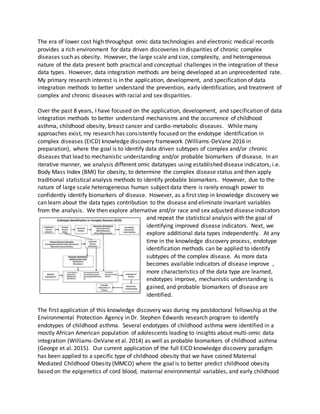
Data integration methods for identifying endotypes and biomarkers of complex diseases
- 1. The era of lower cost high throughput omic data technologies and electronic medical records provides a rich environment for data driven discoveries in disparities of chronic complex diseases such as obesity. However, the large scale and size, complexity, and heterogeneous nature of the data present both practical and conceptual challenges in the integration of these data types. However, data integration methods are being developed at an unprecedented rate. My primary research interest is in the application, development, and specification of data integration methods to better understand the prevention, early identification, and treatment of complex and chronic diseases with racial and sex disparities. Over the past 8 years, I have focused on the application, development, and specification of data integration methods to better understand mechanisms and the occurrence of childhood asthma, childhood obesity, breast cancer and cardio-metabolic diseases. While many approaches exist, my research has consistently focused on the endotype identification in complex diseases (EICD) knowledge discovery framework (Williams-DeVane 2016 in preparation), where the goal is to identify data driven subtypes of complex and/or chronic diseases that lead to mechanistic understanding and/or probable biomarkers of disease. In an iterative manner, we analysis different omic datatypes using established disease indicators, i.e. Body Mass Index (BMI) for obesity, to determine the complex disease status and then apply traditional statistical analysis methods to identify probable biomarkers. However, due to the nature of large scale heterogeneous human subject data there is rarely enough power to confidently identify biomarkers of disease. However, as a first step in knowledge discovery we can learn about the data types contribution to the disease and eliminate invariant variables from the analysis. We then explore alternative and/or race and sex adjusted disease indicators and repeat the statistical analysis with the goal of identifying improved disease indicators. Next, we explore additional data types independently. At any time in the knowledge discovery process, endotype identification methods can be applied to identify subtypes of the complex disease. As more data becomes available indicators of disease improve , more characteristics of the data type are learned, endotypes improve, mechanistic understanding is gained, and probable biomarkers of disease are identified. The first application of this knowledge discovery was during my postdoctoral fellowship at the Environmental Protection Agency in Dr. Stephen Edwards research program to identify endotypes of childhood asthma. Several endotypes of childhood asthma were identified in a mostly African American population of adolescents leading to insights about multi-omic data integration (Williams-DeVane et al. 2014) as well as probable biomarkers of childhood asthma (George et al. 2015). Our current application of the full EICD knowledge discovery paradigm has been applied to a specific type of childhood obesity that we have coined Maternal Mediated Childhood Obesity (MMCO) where the goal is to better predict childhood obesity based on the epigenetics of cord blood, maternal environmental variables, and early childhood
- 2. growth patterns. In addition, metabolomic and microbiomic data types are considered. Throughout the EICD knowledge discovery framework, we have developed tools specific to the use of electronic medical records, MonoInc (Josey et al. 2016 in preparation), identified preliminary sex and race adjusted disease indicators of MMCO (Williams-DeVane et al. 2016 in preparation), and have started to identify endotypes of MMCO that will eventually lead to the identification of probable biomarkers of disease. The EICD knowledge discovery framework is a generalizable framework that can be applied to many diseases and complex problems. At the core of the method is deep phenotyping and deep learning to identify mechanistically distinct subtypes, endotypes, of complex and/or chronic diseases. The applications of these methods are endless and have the potential to lead to more affordable healthcare through the prediction, early identification, and precise treatment of chronic diseases particularly in disparate populations.